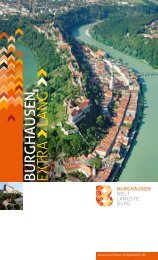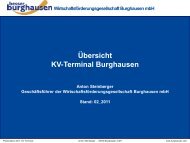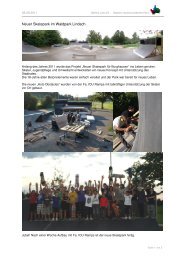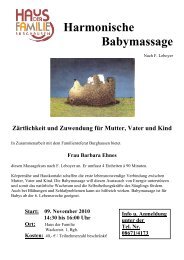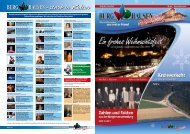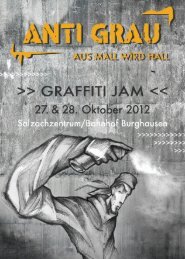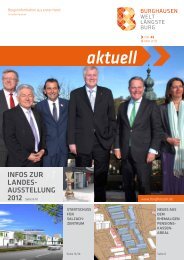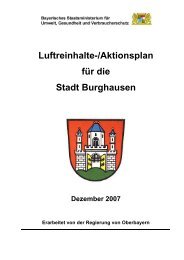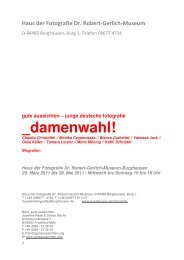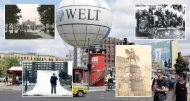D I C H E M - Wirtschaftsförderungsgesellschaft Burghausen mbH
D I C H E M - Wirtschaftsförderungsgesellschaft Burghausen mbH
D I C H E M - Wirtschaftsförderungsgesellschaft Burghausen mbH
You also want an ePaper? Increase the reach of your titles
YUMPU automatically turns print PDFs into web optimized ePapers that Google loves.
<strong>Burghausen</strong> Chemistry Award<br />
10 th -12 th May 2007<br />
D I C H E M 2 0 0 7<br />
I N T E R N A T I O N A L S C I E N T I F I C S Y M P O S I U M
D I C H E M 2 0 0 7<br />
Thursday, 10th May<br />
I N T E R N A T I O N A L S C I E N T I F I C S Y M P O S I U M<br />
Conference Program Location: <strong>Burghausen</strong> (Bürgerhaus); Bürgersaal<br />
Scientific Forum - Part A<br />
Moderation: Prof. Herrmann (President Technische Universität München)<br />
Opening<br />
Keynote: 2:00 p.m.. . . . . . . Prof. W. A. Herrmann (President Technische Universität München)<br />
Lectures: 2:15 p.m.. . . . . . . Prof. R. R. Schrock (Nobel Laureate, Department of Chemistry, Massachusetts Institute of<br />
Technology, Boston/USA)<br />
“ Catalytic Reduction of Dinitrogen to Ammonia at Room Temperature and One<br />
Atmosphere with Protons and Electrons“<br />
2:45 p.m.. . . . . . . Prof. B. Rieger (Wacker Chair for Macromolecular Materials, TUM)<br />
“Biopolymers From Technical Monomers”<br />
3:15 p.m.. . . . . . . Dr. J. Küpfer (Senior Manager Hybrid Materials, Wacker Chemie AG)<br />
“Geniomer® - An Unique Silicone-based Thermoplastic Elastomer“<br />
3:45 – 4:15 p.m. Coffee Break<br />
Lectures: 4:15 p.m.. . . . . . . Dr. A. Virag (Managing Director, OMV Deutschland G<strong>mbH</strong>)<br />
“Raw Material Supply for the Chemical Industry”<br />
4:45 p.m.. . . . . . . H. V. Boelt (Manager Commercialization New Technologies / Research & Development,<br />
Linde Group – Linde Engineering)<br />
“ Alpha-SABLIN - A Newly Developed Technology for Linear Alpha Olefins<br />
Production”<br />
5:15 p.m.. . . . . . . Prof. Kessler (Chair of Organic Chemistry, TUM)<br />
“ Contributions of a Chemist at the Interphase to Medicine, Biomaterials, Biochemistry,<br />
Biophysics and Pharmacy”<br />
5:45 p.m.. . . . . . . Dr. N. Schall (R&D Director Battery Materials; Süd-Chemie AG)<br />
“LiFePO 4 - The Cathode Material for Li-Ion Batteries of the Future”<br />
End: 6:15 p.m.<br />
Friday, 11th May<br />
7:00 p.m.. . . . . . . Welcome drink and get together accopmanied by a jazzband at Mautnerschloss<br />
On Friday morning (9:00 a.m. – 12:00 a.m.) all participating scientists are invited to visit the construction site of the new Wacker Chemie AG plant.<br />
Moderation: Anton Steinberger<br />
Keynote: 9:00 a.m.. . . . . . . Anton Steinberger (Chairman, <strong>Wirtschaftsförderungsgesellschaft</strong> <strong>Burghausen</strong> <strong>mbH</strong>)<br />
Lectures: 9:15 a.m.. . . . . . . Hans Steindl (First Mayor of <strong>Burghausen</strong>)<br />
„The communal responsibility in <strong>Burghausen</strong>’s regional economic policy“<br />
10:00 a.m. . . . . . . Hartmut Bulwien (BulwienGesa AG München)<br />
„The economical importance of the Bavarian Chemical Triangle“ – Presentation of a regional<br />
study, drawn up by assignment of the Bavarian Ministry for economic affairs, transportation and<br />
technology for <strong>Burghausen</strong>, the Altötting district as well as the municipality of Burgkirchen<br />
10:45 – 11:00 a.m. Coffee Break<br />
11:00 a.m. . . . . . . Dr. Stefan Wimbauer (Bayer. Wirtschaftsministerium)<br />
„Cluster politics in Bavaria“<br />
11:45 Uhr . . . . . . Günter Knoblauch (Mayor of Mühldorf am Inn, Chairman of the ‘Borough Alliance Inn-Salzach‘)<br />
– “Strategies and aims of the ‘Borough Alliance Inn-Salzach’ in the scope of regional politics“
12:30 – 14:00 p.m. Lunch<br />
Scientific Forum - Part B<br />
Moderation: Prof. W. A. Herrmann (President Technische Universität München)<br />
<strong>Burghausen</strong> Chemistry Award<br />
10 th -12 th May 2007<br />
Keynote: 2:00 p.m.. . . . . . . Prof. W. A. Herrmann (President Technische Universität München)<br />
Lectures: 2:15 p.m.. . . . . . . Prof. em. Dr. H. Brunner (Institute of Inorganic Chemistry, University of Regensburg)<br />
“Diastereomers do, what they should not do”<br />
2:45 p.m.. . . . . . . Dr. C. Grein (R&D - Polymer Design, Borealis Polymere G<strong>mbH</strong>)<br />
„Product innovations with new catalyst generation“<br />
3:15 p.m.. . . . . . . Dr. G. Wich (Corporate Research, Wacker Chemie AG)<br />
„The Wacker Secretion System - An Unique E. Coli Protein Production Vehicle”<br />
3:45 – 4:15 p.m. . . . Coffee Break<br />
4:15 p.m.. . . . . . . Dr. K. Hesse (Wacker Chemie AG) “Wacker Polysilicon - An Energy Efficient Product”<br />
4:45 p.m.. . . . . . . Prof. J. Plank (Chair of Building Chemistry; TUM)<br />
“ Construction Chemicals – about functional molecules and nano materials“<br />
5:15 p.m.. . . . . . . Prof. D. G. Nocera (Awardee <strong>Burghausen</strong> Chemistry Award 2007,<br />
Department of Chemistry, MIT, Boston/USA)<br />
“On the Global Energy Future and Science’s Challenge to Power the Planet”<br />
End: 5:45 p.m.<br />
On Friday evening the City of <strong>Burghausen</strong> invites to a visit to the traditional Bavarian beer-festival “Mai-Wiesn”<br />
Saturday, 12th May<br />
On Saturday morning the city of <strong>Burghausen</strong> invites all guests to join a guided sightseeing tour (Start: 10:00 a.m.).<br />
This tour starts with a Barge ride on the river Salzach (romantic tour through the salzach valley).<br />
Awards Ceremony at castle Dürnitz<br />
Greeting: 7:00 p.m.. . . . . . . Hans Steindl (Mayor of <strong>Burghausen</strong>)<br />
Introduction: 7:15 p.m.. . . . . . . Prof. W. A. Herrmann (President Technische Universität München)<br />
Award: 7:30 p.m . . . . . . . Award Ceremony (Mayor of <strong>Burghausen</strong>, selection committee)<br />
7:45 p.m.. . . . . . . Awardee speech (Prof. D. G. Nocera)<br />
End: 10:30 p.m.<br />
8:00 p.m.. . . . . . . Ceremony Dinner<br />
The symposium will be organized by the City of <strong>Burghausen</strong>.<br />
<strong>Wirtschaftsförderungsgesellschaft</strong> <strong>Burghausen</strong> <strong>mbH</strong>, Marktler Str. 61, D-84489 <strong>Burghausen</strong>, Germany, Phone: 0049 (0) 8677 / 96769 – 0<br />
For questions concerning the scientific program please contact:<br />
Dr. Georg Schirrmacher. Technische Universität München, Arcisstr. 21, 80333 München, Germany<br />
Email: schirrmacher@zv.tum.de, Phone: 0049 (0) 89 / 289 25234
D I C H E M 2 0 0 7<br />
Der Preisträger / Awardee<br />
Daniel G. Nocera, W.M. Keck Professor<br />
für Energie am Massachusetts Institut für<br />
Technologie ist weithin bekannt als führender<br />
Forscher in erneuerbarer Energie<br />
auf molekularer Ebene. Nocera studiert<br />
grundlegende Mechanismen der Energieumwandlung<br />
in Biologie und Chemie, seit<br />
kurzem mit Hauptfokus auf Fotogeneration<br />
des Wasserstoffs und Sauerstoffs aus Wasser. Die gesamte Wasser<br />
aufspaltende Reaktion setzt die Koppelung von Multielektron Prozesse<br />
zu Protonen voraus, welche energetisch ansteigend sind, somit<br />
einen Lichteinstrahl voraussetzen. Nocera war bahnbrechend für<br />
jedes dieser Forschungsgebiete. Die meisten Beispiele von Multielektron<br />
Fotoumwandlung entstanden in seiner Forschungsgruppe im<br />
letzten Jahrzehnt. Diese Arbeit beruht auf der Verallgemeinerung des<br />
Konzeptes von Zwei-Elektron Mischwertigkeit in der Chemie. Er erschaffte<br />
das Feld von Proton-umwandelnden Elektrontransfer (PCET)<br />
auf mechanischer Ebene, so dass der Elektron und Proton richtig getimed<br />
werden in der Aktivierung von kleinen Energiemolekülen. Im<br />
Rahmen der multielektron Chemie und PCET an richtiger Stelle hat<br />
die Nocera Forschungsgruppe Wasserstoff und Sauerstoff produzierende<br />
Katalysatoren entworfen. Er entwickelte den Piloten, der im<br />
T/V PBS Programm ScienceNow verwendet wurde. Seine PBS NOVA<br />
Show wurde nominiert für den Emmy Award in 2006. In 2005 wurde<br />
ihm der Italgas Prieis für seine grundlegenden Beiträge zur Entwicklung<br />
von erneuerbarer Energie auf molekularer Ebene verliehen. Er<br />
erhielt auch den IAPS Award in 2006 und ist durchaus hocherfreut<br />
und fühlt sich geehrt, den Bugrhauser Preis in 2007 zu erhalten.<br />
Nocera (3. Juli 1957 geboren) bekam frühe Ausbildung an der Rutgers<br />
Universität, erhielt ein B.S. Degree in 1979 mit höchster Auszeichnung.<br />
Er zog nach Pasadena, California, begann die Forschung von<br />
Elektrontransferumwandlung von biologischen und anorganischen<br />
Systemen mit Professor Harry Gray und führte am California Institute<br />
für Technology die ersten Experimente durch. Als graduierter Student<br />
führte er mit Gray die ersten Experimente in Messbereichs-Bestimmung<br />
von Elektrontransfer zu fixierten Abständen in Proteine (cytochrome<br />
c)durch. Dies ist weithin bekannt als Beginn auf dem Gebiet<br />
des biologisches Elektrontransfers. Nach Erlangen seines Ph.D. degree<br />
in 1984, ging er nach East Lansing, Michigan, um seinem Ruf der<br />
Fakultät in Michigan State University zu folgen, trat ein in die Fakultät<br />
von Massachusetts Institute of Technology als Professor in Chemie in<br />
1997. Nocera leitete 85 Ph.D. graduierte Studenten und Doktoranden,<br />
veröffentlichte 225 Fachblätter, gab über 450 Fachvorträge und hatte<br />
25 namhafte Lehraufträge. Nocera arbeitete mit Präsidenten von fünf<br />
I N T E R N A T I O N A L S C I E N T I F I C S Y M P O S I U M<br />
Professor Daniel G. Nocera, W. M. Keck Professor of Energy,<br />
Massachusetts Institute of Technology<br />
Universitäten, um die Energie Initiativen in ihren Instituten zu etablieren.<br />
Er arbeitet mit vielen Fachleuten betreffend der Herausforderung<br />
der globalen Energie.<br />
Daniel G Nocera, W.M. Keck Professor of Energy at the Massachusetts<br />
Institute of Technology is widely recognized as a leading researcher<br />
in renewable energy at the molecular level. Nocera studies basic<br />
mechanisms of energy conversion in biology and chemistry with primary<br />
focus in recent years on the photogeneration of hydrogen and<br />
oxygen from water. The overall water-splitting reaction requires the<br />
coupling of multielectron processes to protons, which are energetically<br />
uphill, thus requiring a light input. Nocera has pioneered each of<br />
these areas of science. Most examples of multielectron photoreactions<br />
have originated from his research group in the past decade. This<br />
work has relied on the generalization of the concept of two-electron<br />
mixed valency in chemistry. He created the field of proton-coupled<br />
electron transfer (PCET) at a mechanistic level so that the electron<br />
and proton could be properly timed in the activation of small molecules<br />
of energy consequence. With the frameworks of multielectron<br />
chemistry and PCET in place, hydrogen- and oxygen-producing catalysts<br />
were designed in the Nocera research group. He developed<br />
the pilot that was used in the T/V PBS program ScienceNow and his<br />
PBS NOVA show was nominated for a 2006 Emmy Award. In 2005,<br />
he was awarded the Italgas Prize for fundamental contributions to<br />
the development of renewable energy at the molecular level. He has<br />
also received the IAPS Award 2006 and he is absolutely delighted and<br />
honored to receive the <strong>Burghausen</strong> Prize 2007.<br />
Nocera (born 3 July 1957) received early education at Rutgers University<br />
obtaining a B.S. degree in 1979 with highest Honors. Moving<br />
to Pasadena, California he began research on the electron transfer<br />
reactions of biological and inorganic systems with Professor Harry<br />
Gray, he performed the first experiments at the California Institute<br />
of Technology. As a graduate student with Gray he performed the<br />
first experiments on measuring rates of electron transfer at fixed<br />
distances in proteins (cytochrome c). This is widely recognized as<br />
beginning the field of biological electron transfer. After obtaining his<br />
Ph.D. degree in 1984, he moved to East Lansing, Michigan to take up<br />
a faculty appointment at Michigan State University, joining the faculty<br />
of the Massachusetts Institute of Technology as a Professor of Chemistry<br />
in 1997. Nocera has supervised 85 Ph.D. graduate and postdoctoral<br />
students, published 225 papers, given over 450 invited talks and<br />
25 named lectureships. Nocera has worked with the president’s of<br />
five universities to establish energy initiatives at their institutions. He<br />
works with many individuals regarding the global energy challenge.
Die Jury / The Jury<br />
Prof. Wolfgang A. Herrmann, Technische Universität<br />
München, Vorsitzender der Jury<br />
ist seit 1995 Präsident der Technischen Universität München.<br />
Unter seiner Leitung sind im letzten Jahrzehnt die<br />
maßgeblichsten Reformprozesse an der TUM erfolgreich<br />
umgesetzt worden. So wurde der TUM 2006 als vorläufiger<br />
Höhepunkt der Status einer Exzellenz-Universität verliehen.<br />
Prof. Herrmann ist Vorstand des Anorganisch-chemischen<br />
Institut der TUM und kann auf über 700 Originalpublikationen<br />
verweisen.<br />
Prof. Jean-Marie Lehn, Collège de France/Strasbourg,<br />
Nobelpreisträger für Chemie 1987<br />
wurde 1987 gemeinsam mit D. Cram und C. Pedersen der<br />
Chemie-Nobelpreis für die Entwicklung und Verwendung<br />
von Molekülen mit strukturspezifischer Wechselwirkung von<br />
hoher Selektivität verliehen. Der Nobelpreisträger ist seit<br />
1979 Professor für Chemie am Collège de France in Strasbourg.<br />
Hauptsächliches Arbeits- bzw. Forschungsgebiet<br />
ist die Supramolekulare Chemie, ein weltweit bearbeitetes<br />
Gebiet zwischen den klassischen Naturwissenschaften und<br />
den Biowissenschaften sowie der Medizin.<br />
Prof. Richard R. Schrock, Massachusetts Institute of<br />
Technology, Nobelpreisträger für Chemie 2005<br />
war einer der Empfänger des Chemie-Nobelpreises im Jahr<br />
2005. Der Nobelpreis wurde im für die Entwicklung der Metathesemethode<br />
für organische Synthesen verliehen. Prof.<br />
Schrock ist seit 1980 Professor Massachusetts Institute of<br />
Technology. Schrock forscht auf dem Gebiet der Organometallchemie,<br />
der synthetischen Chemie, der anorganischen<br />
Chemie, über Katalysatoren und Polymere. Im Speziellen<br />
forscht er an Katalysatoren für die Olefinmetathese und die<br />
Ringöffnungsmetathese-Polymerisationen.<br />
Dr. Rudolf Staudigl, Mitglied des Vorstands der Wacker<br />
Chemie AG, München<br />
ist seit 1995 Mitglied der Geschäftsführung der Wacker-<br />
Chemie G<strong>mbH</strong> und seit November 2005 Mitglied des Vorstands<br />
der Wacker Chemie AG. Seine wichtigsten Stationen<br />
bei WACKER: Ab 1990 President der Wacker Siltronic<br />
Corporation in Portland/OR, USA; nach seiner Rückkehr<br />
1993 Mitglied der Geschäftsführung der früheren Wacker<br />
Chemitronic G<strong>mbH</strong> (heute: Siltronic AG). Als Vorstand der<br />
Wacker Chemie AG ist Dr. Staudigl für die Konzernforschung<br />
zuständig. Zu seinen Ressortzuständigkeiten zählen ferner<br />
Personal (Arbeitsdirektor), Patente und Lizenzen, Umwelt,<br />
Chemikalien und Sicherheit, der Geschäftsbereich WACKER<br />
SILICONES, die Leitung der WACKER-Standorte sowie die<br />
Region Asien.<br />
<strong>Burghausen</strong> Chemistry Award<br />
10 th -12 th May 2007<br />
Prof. Wolfgang A. Herrmann, Technical University Munich,<br />
President of the Jury,<br />
since 1995 President of the Technical University Munich. Under<br />
his direction the relevant reform processes have been<br />
successfully put into action at the TUM (Technical University<br />
Munich) over the last decade. In 2006 the TUM was awarded<br />
‘Exzellenz-Universität’ (Excellent University). Professor Herrmann<br />
is director of the inorganic-chemical institute of the<br />
TUM and can refer to more than 700 publications.<br />
Prof. Jean-Marie Lehn, Collège de France/Strasbourg,<br />
Nobel Prize winner for chemistry in 1987<br />
and – in the same year, together with D. Cram and C. Pedersen<br />
– Nobel Prize winner for the development and utilization<br />
of molecules with structure-specific interaction of high selectivity.<br />
Since 1979 Professor Lehn has been professor for<br />
chemistry at the Collège de France in Strasbourg. His main<br />
field of work and research above all is the supra molecular<br />
chemistry, combining classical and biological science as well<br />
as medicine.<br />
Prof. Richard R. Schrock, Massachusetts Institute of Technology,<br />
Nobel Prize Winner for chemistry in 2005<br />
one of the Nobel Prize Winners for chemistry in 2005. This Nobel<br />
Prize was awarded for the development of the metathesis<br />
method in organic synthesis. Richard R. Schock has been a<br />
professor at the Massachusetts Institute of Technology since<br />
1980. He researches in the field of organometallic chemistry,<br />
synthetic chemistry, inorganic chemistry, catalysts and polymers.<br />
He specialises in catalysts for olefin metathesis and ring<br />
opening polymerisation.<br />
Dr. Rudolf Staudigl, Executive Board Member at Wacker<br />
Chemie AG, Munich<br />
joined the Managing Board of former Wacker-Chemie G<strong>mbH</strong><br />
in 1995. He has been an Executive Board member of Wacker<br />
Chemie AG since November 2005. WACKER career highlights:<br />
President of Portland/OR USA-based Wacker Siltronic Corporation<br />
in 1990; following his return to Germany in 1993, member<br />
of then Wacker Chemitronic G<strong>mbH</strong>’s Managing Board (today’s<br />
Siltronic AG). In his function as Wacker Chemie AG Executive<br />
Board member, Dr. Staudigl is in charge of Corporate R&D.<br />
His other areas of responsibility include Human Resources<br />
(Personnel Director), Corporate Intellectual Property, the<br />
environment, chemicals and safety, as well as the WACKER<br />
SILICONES business division. Moreover, he is in charge of all<br />
WACKER sites and has regional responsibility for Asia.
B U R G H A U S E N<br />
D I E B U R G A N L A G E ( S A N D T N E R M O D E L L V O N 1 5 7 1 )<br />
T H E C A S T L E ( S A N D T N E R M O D E L O F 1 5 7 1 )<br />
D O P P E L W A P P E N G E O R G S T O R<br />
D O U B L E C O A T O F A R M S O N T H E G E O R G S T O R<br />
An den Ufern der Salzach, die Bayern von Österreich trennt, liegt auf bayerischer<br />
Seite <strong>Burghausen</strong>.<br />
1025 nach Christus erstmals urkundlich erwähnt, nimmt Herzog<br />
Heinrich der Löwe die Burghauser Burg 1164 in Besitz. Im Jahre<br />
1229 kommt auch die stadtähnliche Talsiedlung in den Besitz der<br />
Wittelsbacher. Ab 1255 ist <strong>Burghausen</strong>, bedeutend durch seinen<br />
Handel mit Salz aus Hallein, zweite Residenz der niederbayerischen<br />
Herzöge. 1307 erhält <strong>Burghausen</strong> das Stadtrecht durch<br />
Kaiser Ludwig dem Bayern und ist Verwaltungsmittelpunkt als<br />
Rentamt. Im 15. und 16. Jahrhundert, unter den letzten drei niederbayerischen<br />
Herzögen Heinrich, Ludwig und Georg, genannt „die<br />
Reichen“, erfährt die Stadt ihre Blüte- und Glanzzeit. 1627 kommen<br />
die Jesuiten nach <strong>Burghausen</strong>, 1629 wird beschlossen, ein Kollegium<br />
mit Gymnasium und Kirche zu bauen, 1654 wird das Kapuzinerkloster<br />
gegründet und 1683 kommen die Englischen Fräulein in<br />
die Salzachstadt.<br />
Wirtschaftlich schwere Zeiten kommen auf die Burghauser im 17.<br />
und 18. Jahrhundert zu. Die Drangsale der napoleonischen Kriege<br />
ab 1800 mögen dabei eine Rolle gespielt haben, die Stadt sank zur<br />
unbedeutenden Kleinstadt herab.<br />
Gut hundert Jahre später, mit der Gründung der Wacker-Chemie<br />
im Jahr 1915 beginnt in <strong>Burghausen</strong> nicht nur ein neues Kapitel<br />
der Stadtchronik, es beginnt eine neue Geschichte: Die Stadt entwickelt<br />
sich stürmisch, Geschäfte und Gewerbebetriebe siedeln<br />
sich an. Die Stadt steht abermals an einem Wendepunkt ihrer<br />
Geschichte, startet eine „zweite Karriere“, die sich als besonders<br />
erfolgreich herausstellen soll.
G E S C H I C H T E H I S T O R Y<br />
H A N D W E R K E R M E I L E „ D I E G R Ü B E N “<br />
T H E “ G R Ü B E N ” F O R M E R LY ‘ A R T I S A N ’ S L A N E ’<br />
B U R G U N D W Ö H R S E E<br />
C A S T L E A N D L A K E „ W Ö H R S E E “<br />
<strong>Burghausen</strong> is situated on the Bavarian side of the river Salzach, which separates<br />
Bavaria from Austria.<br />
<strong>Burghausen</strong> was fi rst mentioned in a legal document in 1025. In<br />
1164 Duke Heinrich der Löwe (Henry ‘the Lion’) took possession<br />
of <strong>Burghausen</strong> castle. In the year 1229 the settlement in the valley<br />
came into the possession of the Wittelsbacher family. From<br />
1255 onwards <strong>Burghausen</strong> was an important salt trading centre<br />
with salt from Hallein, the second residence of the lower Bavarian<br />
dukes. In the year 1307 Kaiser Ludwig der Bayer (Emperor Ludwig<br />
‘the Bavarian’) appointed <strong>Burghausen</strong> a ‘town’ and turned it into<br />
an administrative centre regarding governmental power and fi nancial<br />
administration. <strong>Burghausen</strong>’s heyday was during the 15th and<br />
16th century under the last three Lower Bavarian Dukes: Heinrich;<br />
Ludwig and Georg, ‘the Rich’. The Jesuits came to <strong>Burghausen</strong><br />
in1627. In 1629 it was decided to construct a college with grammar<br />
school and church. 1654 the capuchin monastery was founded,<br />
followed in 1683 by the convent of the “Englischen Fräulein”.<br />
The citizens of <strong>Burghausen</strong> were facing economically hard times<br />
during the 17th and 18th century. The distressing times of the Napoleonic<br />
wars after 1800 may have been one reason for the downward<br />
trend: <strong>Burghausen</strong> became a negligibly small town.<br />
More than century later, in the year 1915, a new era began with the<br />
founding of “Wacker-Chemie”.<br />
In fact, it turned out to be the start of a new chapter in <strong>Burghausen</strong>’s<br />
history. The town prospered as more companies and industrial enterprises<br />
were encouraged to settle here. Once again the town<br />
stood at a turning point in its long history and it started its ‘second<br />
career’, which turned out to be an extremely successful one.
B U R G H A U S E N<br />
W E R K S A N L A G E W A C K E R<br />
W A C K E R - C H E M I E P L A N T<br />
<strong>Burghausen</strong> ist heute einer der erfolgreichsten Wirtschafts- und<br />
Innovationsstandorte Bayerns. Im Bayerischen Chemiedreieck<br />
gelegen, ist die Stadt mit ihrer modernen Infrastruktur Firmensitz<br />
für bedeutende international tätige Unternehmen. Das Bayerische<br />
Chemiedreieck zu dem <strong>Burghausen</strong> zählt, erzielt einen geschätzten<br />
jährlichen Gesamtumsatz von etwa 8 Milliarden Euro. Seit fast<br />
100 Jahren wird hier Chemie-Geschichte geschrieben.<br />
Es begann 1914: Von Dr. Alexander Wacker wird die Wacker Chemie<br />
gegründet. Mit inzwischen 10.000 Mitarbeitern ist sie heute<br />
größter Arbeitgeber Ostbayerns. Die Stadt ist Firmensitz und Raffi -<br />
neriestandort der OMV Deutschland, eine Tochter des österreichischen<br />
OMV Konzerns und sie ist Produktionsstandort der Borealis,<br />
die Polyethylen und Polypropylen zur Weiterverarbeitung in<br />
der Kunststoffi ndustrie herstellt.<br />
B Ü R G E R H A U S<br />
C I T I Z E N ’ S C O M M U N I T Y C E N T R E<br />
Der Wirtschaftsstandort <strong>Burghausen</strong> ist erstklassig, die Lebensqualität wird<br />
großgeschrieben, das Kulturangebot ist überdurchschnittlich, der Freizeitwert<br />
phantastisch.<br />
Eine Vielzahl an kleinen, mittelständischen und großen Gewerbe-<br />
und Industriebetrieben, Dienstleistern und Zulieferern arbeiten in<br />
<strong>Burghausen</strong> und in der unmittelbaren Nachbarschaft. Schwerpunkt<br />
ist die Chemie. <strong>Burghausen</strong> als pulsierendes Wirtschaftszentrum<br />
in Bayern übt insbesondere auch große Anziehungskraft<br />
auf den oberösterreichischen sowie den Salzburger Grenzraum<br />
und die angrenzenden Landkreise aus.
W I R T S C H A F T E C O N O M Y<br />
B U S I N E S S C E N T E R B U R G H A U S E N<br />
B U S I N E S S C E N T R E B U R G H A U S E N<br />
Today <strong>Burghausen</strong> is one of the most successful locations in Bavaria<br />
concerning industry and innovation. Situated In the Bavarian<br />
Chemical Triangle, the town with its modern infrastructure is home<br />
to the headquarters of important internationally active companies.<br />
The Bavarian Chemical triangle to which <strong>Burghausen</strong> belongs,<br />
produces an estimated annual total turnover of approximately<br />
eight billion Euros.<br />
For almost 100 years chemical history has been written here, commencing<br />
in 1914, when Dr. Alexander Wacker established ‘Wacker-Chemie’.<br />
With currently approximately 10.000 employees it is<br />
the largest employer in Eastern Bavaria. The German headquarters<br />
and the refi nery of OMV Germany, a subsidiary of the Austrian<br />
company ‘OMV’, are located in <strong>Burghausen</strong> as well as the production<br />
site of ‘Borealis’, producing polyethylene and polypropylene<br />
for further processing in the plastic industries.<br />
O M V R A F F I N E R I E<br />
O M V R E F I N E R Y<br />
The industrial location of <strong>Burghausen</strong> is fi rst class, the quality of life is highly<br />
rated, the cultural offer is outstanding, the recreational facilities are extraordinary.<br />
A number of small, middle and large industrial companies, service<br />
providers and suppliers are working in <strong>Burghausen</strong> and its immediate<br />
neighbourhood. The focus is on chemistry. <strong>Burghausen</strong> is<br />
the pulsating economical centre of Bavaria and a large attraction<br />
to Upper Austria as well as the Salzburg area and the adjoining<br />
counties.
B U R G H A U S E N<br />
J A Z Z W O C H E N B U R G H A U S E N<br />
J A Z Z F E S T I V A L B U R G H A U S E N<br />
<strong>Burghausen</strong> ist die Stadt des Jazz, der Kunst, der Konzerte, der<br />
Feste. <strong>Burghausen</strong> ist Theater, Schauspiel, Kabarett, Kleinkunst,<br />
Folklore. Wer <strong>Burghausen</strong> besucht, kann sich eines bunten Kulturprogramms<br />
sicher sein. Neben der weltberühmten Burghauser<br />
Jazzwoche, den historischen Festen und Festspielen, ist die Stadt<br />
Podium für Kunst und Künstler in reizvoller historischer Kulisse.<br />
Mit ihren 1.043 Metern ist die Burg zu <strong>Burghausen</strong> die längste<br />
Burganlage Europas, die zu den besterhaltenen mittelalterlichen<br />
Wehrbauten zählt. Sie besteht aus sechs für sich abgeschlossenen<br />
Höfen, gesichert durch Tore, Gräben und Zugbrücken. Mauern,<br />
Zinnen und Türme ziehen sich über die schmale Bergzunge.<br />
Auf der einen Seite fällt der Blick in die Altstadt, auf der anderen<br />
auf den Wöhrsee, eingerahmt von Salzach und den waldreichen<br />
Ausläufern der Alpen. Gelebt werden das jährliche Burgfest und<br />
T H E A T E R U N D C A B A R E T<br />
T H E A T E R A N D C A B A R E T<br />
Kultur ist angesagt, das ganze Jahr über. Zahlreiche Veranstaltungen ernten in der<br />
Stadt der Gegensätze große Anerkennung, weit über Deutschland hinaus.<br />
andere historische Veranstaltungen. Museen, Ausstellungen und<br />
Konzerte geben der Burganlage einen großartigen Rahmen.<br />
Der glitzernde Fluss Salzach, die Burganlage und die Altstadt<br />
bilden einen Dreiklang. Dabei blieb die mittelalterliche Altstadt<br />
in ihrer einzigartigen städtebaulichen Geschlossenheit erhalten.<br />
Den prächtigen Stadtplatz dominieren Gebäude aus dem 14. bis<br />
17. Jahrhundert. Südseitig mündet der Stadtplatz in die Grüben,<br />
die ehemalige Handwerkermeile <strong>Burghausen</strong>s und heutige Fußgängerzone.<br />
Kommen Sie mit und begleiten Sie uns durch die herrliche Burghauser<br />
Stadt. Erleben Sie schöne Augenblicke in der Stadt der Gegensätze<br />
und der Besonderheiten und wir versprechen Ihnen, Sie<br />
werden <strong>Burghausen</strong> in ganz besonderer Erinnerung behalten.
K U N S T & K U L T U R A R T & C U L T U R E<br />
H I S T O R I S C H E F E S T E<br />
H I S T O R I C A L F E S T I V A L S<br />
<strong>Burghausen</strong> is the city of jazz, art, concerts, festivities.<br />
<strong>Burghausen</strong> is theatre, spectacle, cabaret, revue, folklore.<br />
Whoever visits <strong>Burghausen</strong>, will certainly be entertained. Beside<br />
the famous jazz week, the historical celebrations and festival<br />
performances, the city is a podium for art and artists in exquisite<br />
historical settings.<br />
<strong>Burghausen</strong> has the longest castle in Europe – more than<br />
1 kilometre long. It is a well preserved medieval fortress. It<br />
consists of six closed court yards, secured by massive gates,<br />
trenches and drawbridges. The walls, battlements and towers<br />
are built along a steep ridge. One side overlooks the old town,<br />
one side the Wöhrsee (lake Wöhr), framed by the river Salzach<br />
and the rich wooded foothills of the alps. The annual castle<br />
festival depicts life as it was in medieval times. Other historical<br />
K L O S T E R A N L A G E R A I T E N H A S L A C H<br />
M O N A S T E R Y R A I T E N H A S L A C H<br />
Culture is on the agenda throughout the year. Numerous events win large<br />
acknowledgements in this town of contrast, spreading far beyond the borders of<br />
Germany.<br />
arrangements, museums, exhibitions and concerts give the<br />
castle a vibrant vitality.<br />
The glittery river Salzach, the castle and the old town form a<br />
triad. The medieval old town remained in its original form. The<br />
magnifi cent city centre is dominated by buildings of the 14 th and<br />
17 th century. On its southern end the city centre leads into the<br />
‘Grüben’, formerly ‘artisan’s lane’, now pedestrian zone.<br />
Come and join us in marvellous <strong>Burghausen</strong>. Enjoy wonderful<br />
moments in this very special town full of contrasts and leave with<br />
unforgettable memories.



